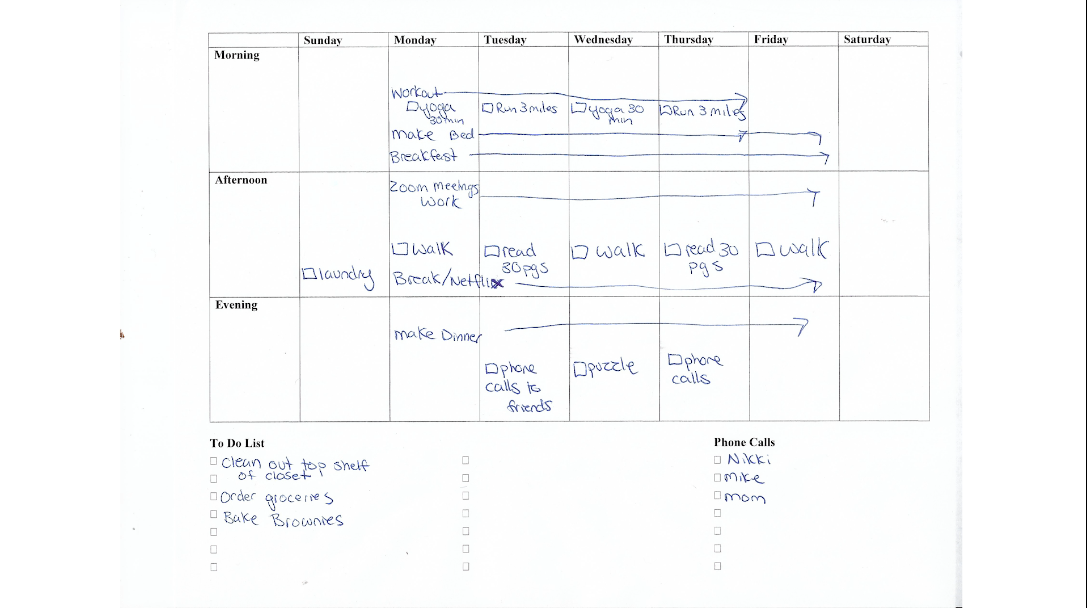Mental Health: Creating and Following Routines
Creating Routines can help us feel productive and successful and offer us the opportunity to visualize what your day or week will look like.
The idea of routines isn’t something new. It’s something that we all use on an everyday basis. We have routines to make our life easier. We usually might have a routine in the morning where you might get up, go for a run, shower, make the bed, eat breakfast, check your email, get your keys, get your phone and head out the door. Our routines are created so that we’re able to get things done easily. Routines often are created with deadlines in mind, or with specific schedules. You need to be work at nine o’clock. And so you need to get these things done before the day starts.
So what happens in a time where we have fewer things scheduled, where we don’t have as many deadlines? It can seem a lot more challenging to create this routine and to stick with it. But the truth is, research shows that our brains are really wired for these routines and like that predictability. That might explain why on the weekends, we often get up at six in the morning, even if we don’t want to.
How do I create a routine so that I can feel successful and I can feel productive in my day?
The truth is it’s really a lot easier than we might think. The way I like to start a routine is just by writing down all the things I need to do and I want to do. So these could include things like the laundry, or it might include going for a walk or a run. And I even like to write down those things that I’m going to do for a break. So maybe it’s watching a new show on Netflix or using my Headspace app.
After I write all these things down, I might either create a daily schedule or a weekly routine, with my day broken into chunks rather than specific times so that we don’t feel bogged down by completing things at a particular time. We’re allowed to see what our day looks like for the morning and the afternoon and the evening and fill in what works best for us. This is an example of a routine I might create where in the morning, every day, Monday through Friday, I get up, I work out, I make my bed and I have breakfast. It’s automatic and it’s familiar.


Routines aren’t just for adults. They really help children as well. In my family, my son has always gone to daycare and when all of a sudden he had to be home every day, we weren’t quite sure how we were going to structure our day. So I asked my son, “What is it that you do every day at school? What’s your routine?” And really easily he told me, “Well, we eat breakfast. We have circle time. We go outside. We have free play. We have a snack.” And so we wrote it down. This allowed us to have some predictability and some structure throughout our day. And if you asked my son why he likes routine, he’ll tell you, “It makes me feel like I’m at school.” It gives him a sense of normalcy.
So as you build your routine, write down those things you want to do, or you need to do. Put it in a weekly or a daily calendar so you can see what your day looks like. Check things off when you complete them so that you feel successful. I promise you it will feel good at the end of the day.
 About the Author: Rachael is a speech-language pathologist at Home Base. She has more than 10 years of clinical experience working in cognitive rehabilitation. Rachael specializes in working with adults who present with language and cognitive challenges due to strokes, traumatic brain injuries, and post-concussive syndrome. In addition to individual therapy, she has developed and leads several community groups. One of Rachael’s favorite parts of working with the neuro-rehab population is helping people learn new skills and techniques so that they can resume doing the things that they enjoy.
About the Author: Rachael is a speech-language pathologist at Home Base. She has more than 10 years of clinical experience working in cognitive rehabilitation. Rachael specializes in working with adults who present with language and cognitive challenges due to strokes, traumatic brain injuries, and post-concussive syndrome. In addition to individual therapy, she has developed and leads several community groups. One of Rachael’s favorite parts of working with the neuro-rehab population is helping people learn new skills and techniques so that they can resume doing the things that they enjoy.


 Home Base
Home Base